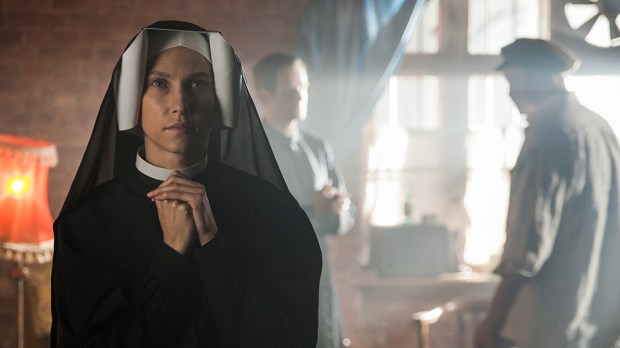For many the image of the Divine Mercy is a familiar one, even if they aren’t exactly aware what it means.
Prayer cards featuring Jesus dressed in a white robe, with rays of red and white light streaming from his heart, can be found in Catholic bookstores and are often found among the free handouts offered in church vestibules.

The new movie Love and Mercy, in select theaters on December 2, explains to the uninitiated the meaning of the familiar image through the story of St. Faustina, the young Polish nun responsible for making the Divine Mercy image known to the world in order to share Jesus’ message of infinite love.
For the Polish actress Kamila Kaminska, the experience of preparing for the role of Faustina in the film was life-changing.
Growing up in Poland, where the image can be found in almost every church, she was aware of“the existence” of St. Faustina. As she delved deeper into Faustina’s story, Kaminska says, she came to feel “as if St. Faustina invited me for a walk in the gardens of Mercy.”
St. Faustina’s visions of Jesus
Faustina’s story begins in the 1930s, before she entered a convent, when, as a young Maria Faustyna Kowalska, she experienced several visions of Jesus, which she recorded in her diary. Dressed in a white garment, with rays of light emanating from his heart, Jesus told her of his merciful love for all people:
“In the Old Covenant I sent prophets wielding thunderbolts to My people. Today I am sending you with My mercy to the people of the whole world. I do not want to punish aching mankind, but I desire to heal it, pressing it to My Merciful Heart.”
What’s more, he had a job for her. He asked her to paint an image showing him as he appeared to her, with the words, “Jesus I trust in you,” written upon it.
In her diary Faustina recorded his promise “that the soul that will venerate this image will not perish,” and his request that “this image be venerated, first in your chapel, and [then] throughout the world.”
The docudrama, which had a successful U.S. debut on October 28, tells the story of Faustina’s initial difficulties finding someone to believe her, and how with the help of the priest Fr. Michael Sopocko, she had an artist execute the painting to her exact specifications. Millions of people today carry a devotion to that image in their hearts— one that was shared by Pope John Paul II himself, who championed the cause of Faustina’s canonization, officially declaring her a saint on April 30, 2000.
The actress lived life as Faustina did
To prepare for her role, Kaminska read Faustina’s diaries and followed in her footsteps.
“I read the diary in full, also partly in the form of an audiobook. I spent some time in two monasteries: in Warsaw, at the Sisters of Divine Mercy, and in Ostrówek, at the Sisters of Merciful Jesus — the house of St. Faustina, where she lived and worked before going to the convent. I had the opportunity to be in her room, walk her paths, stay in silence and talk to the sisters, read her memories,” she told Aleteia.
An intense religious experience resulted
In playing the part of Faustina, Kaminska, who is a practicing Catholic, said she entered into prayer in a deeper way than she had ever experienced.
“I think playing this character was for me an invitation to emphasize personal prayer, focusing on my relationship with God. I think it is a process that has begun — Stand in Truth, School of Trust, and Love,” she said.
When asked if she had any personal experiences with the Divine Mercy devotion that she would like to share, Kaminska described a profound, even ecstatic experience.
“I felt as if St. Faustina invited me for a walk in the gardens of Mercy. Sometimes there were also marshes, where beautiful flowers grow. My heart was so burning with the heat of love that sometimes I thought it would pop out. And I also got a lot of peace,” she said.
The human side of the saint
Kaminska’s portrayal of the saint isn’t all hagiography, as she deftly turns Faustina’s moments of impatience with those who don’t believe her story into actual laugh-out-loud comic moments.
“Besides being the secretary of God’s mercy, Faustina was a human, too, and a sinner, like all of us. To get closer to her, the director and I wanted to show her human character, what is weakness, what is strong,” she said, adding that, “St. Faustina was called ‘smirk’ by other sisters.”
“I, as an actress, am just a tool..”
Kaminska says she came to see playing the role of Faustina as a way to help spread the Divine Mercy message.
“We are tools in God’s hands. I treated this character as the one who … through her the power of God’s Mercy, can pass onto others. In the same way I, as an actress, am just a tool showing Faustina and her message,” she said.
‘Love and Mercy’ can be seen for an encore performance on December 2 in select theaters. Tickets can be purchased here.

